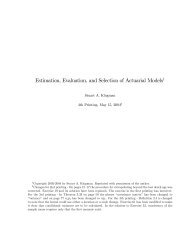A Note On ARMA Model Parameter Redundancy - Department of ...
A Note On ARMA Model Parameter Redundancy - Department of ...
A Note On ARMA Model Parameter Redundancy - Department of ...
Create successful ePaper yourself
Turn your PDF publications into a flip-book with our unique Google optimized e-Paper software.
A <strong>Note</strong> <strong>On</strong> <strong>ARMA</strong> <strong>Model</strong> <strong>Parameter</strong> <strong>Redundancy</strong><br />
A.I. McLeod<br />
<strong>Department</strong> <strong>of</strong> Statistical & Actuarial Sciences<br />
The University <strong>of</strong> Western <strong>On</strong>tario<br />
London, <strong>On</strong>tario N6A 5B9<br />
Canada<br />
Citation: The Journal <strong>of</strong> Time Series Analysis, Vol. 14, No. 2, pp.207{208.<br />
April 1991
2 <strong>ARMA</strong> <strong>Redundancy</strong><br />
Abstract<br />
A simple condition, which is expressed directly in terms <strong>of</strong> the <strong>ARMA</strong> model parameters,<br />
is given for determining <strong>ARMA</strong> model redundancy.<br />
Key words and phrases: Auxiliary matrix, Mathematica, model redundancy roots <strong>of</strong><br />
polynomial equations.
A.I. MCLEOD 3<br />
The stationary and invertible <strong>ARMA</strong>(p q) model, which may be written in operator<br />
notation as,<br />
(B)z t = (B)a t <br />
where, (B) =1; 1B ; :::; p B p (B)=1; 1B ; :::; q B q a t is white noise with<br />
variance 2 a and B is the backshift operator on t, is said to be not redundant if and only<br />
if (B) = 0 and (B) = 0 have no common roots. Due to stationarity and invertibility,<br />
all roots <strong>of</strong> the equation (B)(B) = 0 are assumed to be outside the unit circle. As<br />
shown in Box and Jenkins (1975, p.240) the large sample Fisher information matrix per<br />
observation may bewritten,<br />
I( ) = 1 2 EfA t A T t g<br />
a<br />
where A t = (v t;1:::v t;p u t;1:::u t;q ) (B)v t = ;a t (B)u t = a t and the<br />
superscript T denotes the transpose. Poskitt and Tremayne (1981) showed that the information<br />
matrix I( ) isnonsingular if and only if the model is not redundant and<br />
that the number <strong>of</strong> common roots is equal to the nullity <strong>of</strong> I( ). In fact, this condition<br />
holds for a much simpler matrix J.<br />
The auxiliary matrix, J, <strong>of</strong> an <strong>ARMA</strong>(p q) model is dened by<br />
J =<br />
p<br />
p + q i;j ; i;j<br />
<br />
q<br />
where, 0 = 0 = ;1 i =0 (i p) i =0 (i q) and the (i j)<br />
entry in each partitioned matrix is indicated. The matrix J plays an important role in<br />
the duality theory for <strong>ARMA</strong> time series models (McLeod, 1984).<br />
The autoregressive adjoint <strong>of</strong> the <strong>ARMA</strong>(p q) model is dened by<br />
(B)w t = a t <br />
where,<br />
(B) =(B)(B)<br />
=1; 1 B ; :::; p+q :
4 <strong>ARMA</strong> <strong>Redundancy</strong><br />
Then from McLeod (1984),<br />
I( ) =JI( )J T :<br />
Since I( ) is positive denite, the result follows from the result <strong>of</strong> Poskitt and<br />
Tremayne (1981) and Sylvester's law <strong>of</strong> conservation.<br />
Simple algebraic conditions which give a necessary and sucient condition for lack<br />
<strong>of</strong> model redundancy can be derived by setting the determinant <strong>of</strong> J not equal to zero.<br />
This is easily implemented using the Mathematica programming language (Wolfram,<br />
1988). Using Mathematica, thefollowing condition was derived for the <strong>ARMA</strong>(2,2)<br />
model:<br />
2 2 + 121 ; 21 2 ; 1 2 2 ; 222 + 112 + 2 2 6=0:<br />
It should be noted that the result given in this paper is mostly <strong>of</strong> theoretical interest.<br />
In practice, when tting models to data, model redundancy is indicated when the<br />
covariance matrix <strong>of</strong> the parameters is nearly singular or the estimates <strong>of</strong> the standard<br />
deviations <strong>of</strong> the parameters are quite large. Exact model redundancy <strong>of</strong> the type discussed<br />
in this note does not arise when tting models to data due to the uncertainty in<br />
the parameter values.<br />
Acknowledgments<br />
A referee is thanked for helpful comments.<br />
REFERENCES<br />
Box, G.E.P. and Jenkins, G.M. (1975) Time Series Analysis: Forecasting and Control<br />
(2nd edn). San Francisco: Holden-Day.<br />
McLeod, A.I. (1984) Duality and other properties <strong>of</strong> multiplicative seasonal<br />
autoregressive-moving average models, Biometrika, 71, 207{11.
A.I. MCLEOD 5<br />
Poskitt, D.S. and Tremayne, A.R. (1981) An approach to testing linear time series<br />
models, The Annals <strong>of</strong> Statistics, 9,974{986.<br />
Wolfram, S. (1988) Mathematica: A System for Doing Mathematics by Computer,<br />
Redwood City: Addison-Wesley.
















